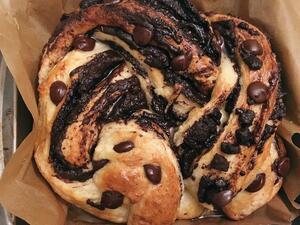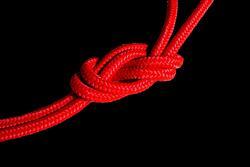Baking Babka, Taking in Tragedy
On a good day, I feel merely overwhelmed by the news. I cyclically commit to cutting back on my media consumption: I delete apps from my phone and read a book instead of the internet before bed, but inevitably, I dip back in for fear of being uninformed.
The morning of the Pittsburgh shooting, I am working a Saturday shift canvassing for a cause I believe in. My phone buzzes and I read the words from a friend on the East Coast hastily—“Hi dear: just hope you are feeling loved and supported today.” I’m puzzled. “Always do!” I shoot back, with a confused emoji face. “Hope you feel the same!” I put my phone back in my pocket and resume scanning my map, sweat already beading at my brow from the slanting desert sun. My pocket buzzes again. “Did you not see the news?” I feel my entire body tense, my fingers shaking as I struggle to open Twitter. In a moment, I am inundated—11 dead, maybe more.
I make it through a few more houses before bowing out for the day, wordlessly embracing my partner when I get home. I am nervous, and need something to do with my hands. My mind races through possible actions: Go to a synagogue? Journal? Call my parents? I feel nauseated trying to balance the pressure I feel to be eloquent and performatively mournful for my non-Jewish friends checking in. Are people expecting me to write a Facebook post? Will I seem callous for wanting to focus on literally anything else? In the end, I fall into a fitful, angry nap on the couch while my partner quietly grades papers beside me.
When I wake up, I decide to make a babka.
I have never made one before. I know from cursory glances at recipes that it’s time consuming. Previously, that had been a deterrent, but now I need a single task to focus on. I had intended to attempt baking one at some point in November, in service of a light-hearted blog post. Now, I gather my materials quickly, desperate to get moving on a project.
The first step involves mixing all the dry ingredients together, slowly folding in the eggs. The mixture begins to consolidate into dough as I work, and I reach inside the bowl, mesmerized, manipulating it with my hands and imagining a frenzy of yeast growing and expanding within. The dough needs eight hours to rise, so I leave it underneath a kitchen towel my partner’s mother sent us for Rosh Hashanah. It’s covered in stitched apples.
I research the history of babka in the slow interim, lazily punching “babka origin” into a search engine. Dozens of articles pop up. Babka is well-loved and well-known, having recently moved from delicatessen shelves to curated Instagram feeds. Jewish food, particularly of the Ashkenazic variety, seems to be suddenly everywhere. With the rise in nationwide interest comes the bastardizations and goyishe imitations (rainbow bagels are not bagels, mishpacha) of Jewish dishes. I remain shocked that beef tongue and Cel-Ray have yet to become hipster meal staples.
As I jump from site to site, jotting down information that feels particularly relevant, the suggested articles floating alongside the text I’m trying to read are related to Pittsburgh. I feel a rush of anger again—fleeting, but sharp, nestled somewhere under my ribcage. My partner and I often joke, as our parents and grandparents did before us, about the sweet and the bitter coexistence that exists within Jewish lives. There has always been the moment of fear when we hear a door opening in the synagogue after services have begun, the subheading of “Persecutions” floating under the Wikipedia entry for Judaism. I feel disoriented toggling between my desire to say something profound about what it means to be Jewish, even secularly, in the United States today, and my desire to write about my struggle to braid a babka loaf. I want to enjoy the sweet fruits of my labor without the bitter reminder that life is chaotic and short and often heartbreaking.
Here are some things I learn about babka on the Thursday after the Tree of Life shooting, while waiting for my dough to rise:
1. Babka is an Eastern-European import, and not technically exclusive to Jewish communities though the form we recognize it in today came from New York City Jewish immigrant circles.
2. Chocolate babka is uniquely American. Cinnamon and jam were more popular fillings in the Old Country, as chocolate was priced out of reach for most people.
3. Babka starts to dry out after about 24 hours so most bakers today wash their finished loaves in a sugar syrup, giving them their signature glisten and prolonging their lifespans.
The first babka I ever ate was from Trader Joe’s. This is the standard against which I’m judging my own baking. It’s hardly as poetic as, say, a memory of Bubbe making a babka by hand, or a childhood experience of eating a slice in an obscure deli in New York. My grandmother has, to the best of my knowledge, never baked for me, and as a child, I was far more invested in black and white cookies.
After eight hours in the fridge, I pull the dough out to find it has doubled in size. This is enormously relieving; the idea of starting the rising process over again is entirely too much to bear. The kitchen slips into darkness as I try to shape the dough into a flattened rectangle. I realize after a few minutes we have no rolling pin, and the task becomes that much more engrossing. I’m straddling the counter, trying to pull and flatten the dough by hand, fully leaning my weight in and grunting with the effort. I cover my makeshift rectangle with Saran wrap and books and move on to the filling: cocoa powder, dark chocolate, confectioners sugar, and butter. I spoon the warm filling directly from the pot onto the dough, letting it seep out as I attempt to twist what I’ve made into some kind of recognizable shape.
I settle for a braided crown of sorts. With no loaf pan available, I tuck the dough in on itself inside a pie dish, carefully studding the edges with chocolate chips. I sit in front of my oven like I’m on Bake Off while I wait for my work to transform. For all my approximations and shortcuts and improvisations, the end result is edible. My partner and I are too greedy to sugar glaze the babka, opting instead to cut into it while it’s still hot. We let ourselves laugh and fill up on the sweet, not the bitter—opting to celebrate nothing and everything on a Saturday night.
The Babka recipe I used originally comes from Jerusalem: A Cookbook by Yotam Ottolenghi and Sami Tamimi. A version of it can be found here.








I'm impressed; first that you had the ingredients on hand and then that you were able to use your energy to produce something that had to have felt so essentially Jewish. I, on the other hand, recently widowed after a 55 year marriage, sat immobile, tied up in knots at the savagery and my lack of a partner with whom to share the grief. I made a donation to HIAS and tried to get back to the business of living. And I think, ultimately, that is what we must do: live for ourselves and for those who no longer can.